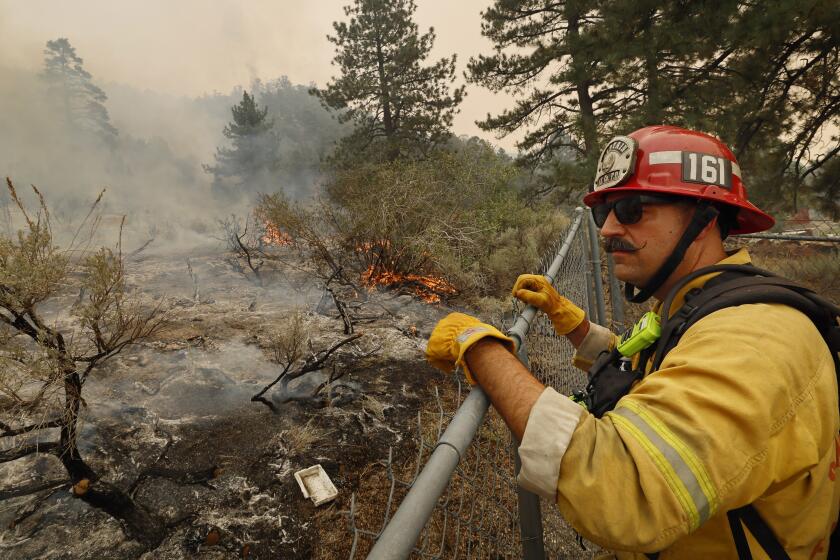Faulty Sensor Cited as Cause of Blackouts
The first rolling blackouts in California since the power crisis of 2001 were caused by a faulty sensor at a new power transfer station in Sylmar, raising concerns about how such a relatively minor glitch could leave nearly 500,000 customers without electricity.
The $118-million facility, operated by the Los Angeles Department of Water and Power, was opened with much fanfare last fall. But officials now believe a malfunction in a sensor that monitors a cooling system at the station triggered an automatic shutdown Thursday afternoon.
The resulting blackouts underscored the fragility of the state’s power grid. Experts said the incident showed once again that California doesn’t have the power plants or the transmission capacity to reroute electricity when a major transmission line goes down. California is particularly dependent on power generated outside the state -- especially during the summer, when customers crank up air conditioners.
“We have a fragile system in California, and we have more people moving to this state,” said Anne Silva, a spokeswoman for San Diego Gas & Electric, which was forced to cut power to more than 51,000 customers for nearly an hour. “When we rely on just a few transmission lines in the state, and something happens, then it kind of has a domino effect.”
Officials at the DWP spent Friday urgently working with the manufacturer of the equipment, ABB Inc., to determine why the sensor failed and to prevent a recurrence.
This is crucial, said Henry Martinez, chief operating officer of power for the DWP, because the same type of sensor is used in other power-distribution equipment.
“We’ve got to get this fixed to make sure this doesn’t happen again,” Martinez said.
The malfunction occurred at the Sylmar Converter Station, the terminus of one of California’s major north-south electric transmission lines. The facility is where Southern California receives electricity from power plants in Oregon, Martinez said.
At the Sylmar facility, electricity is distributed to local electric grids that deliver it to homes and businesses throughout Southern California.
Martinez said that at 3:45 p.m., a malfunctioning sensor signaled a problem in the cooling system of a transformer, and that automatically shut down one of the station’s two main converters, which forced officials to temporarily shut down the entire facility.
That instantaneously prompted the shutdown of power generation at dams on Oregon’s Columbia River and at least one gas-fired generator in the Portland area, said Ed Mosey, spokesman for the Bonneville Power Administration in Oregon.
In the meantime, faced with a sudden shortage of power on a day of 100-degree temperatures, the California Independent System Operator, the not-for-profit entity that oversees the state power grid, ordered rolling blackouts.
They affected more than 400,000 customers of Southern California Edison, including residents of Long Beach, Santa Barbara, Irvine, Chino Hills, Palm Desert, Torrance, and San Bernardino.
Pasadena, which has its own electric utility, also had some blackouts.
The blackouts ranged from 30 minutes to an hour.
At 4:28 p.m., power flow in Sylmar resumed at 50% capacity. It was back at full capacity early Friday.
Los Angeles was not affected because the DWP was not purchasing a substantial amount of electricity through Sylmar at the time of the outage Thursday and was able to compensate with its own generators, Martinez said.
“All the right conditions were there” for rolling blackouts, Martinez said. “Demand was high, and one little blip like this upset the delicate balance of supply and demand.”
Stephanie McCorkle, spokeswoman for the Independent System Operator, said the system might have been able to handle the malfunction had temperatures been cooler and electricity demand lower.
“There was a 14-degree jump in temperatures over what anyone expected,” she said.
Martinez likened the problem to a faulty oil light coming on in the car -- only in this case, the oil light automatically causes the car to shut down. In the case of the power distribution center, this is done to protect the transformer from being damaged by excessive heat.
The owners of the Sylmar transfer station -- Southern California Edison, the DWP and the city-owned utilities in Burbank, Glendale and Pasadena -- paid to dramatically overhaul the facility, whose equipment dated to the 1970s, to improve its reliability.
“This was just commissioned back in September of last year,” Martinez said. “We’re surprised that it happened. This particular installation has been running for several months now, and it has been tested.”
To energy officials, Thursday’s blackouts point to a much larger problem.
“It does have the appearance that there was nothing to fall back to -- there was no alternate transmission path. There were no sufficient alternate power plants to pick up the load from the loss” of the transmission line, said Randy Howard of the DWP.
While about 10,000 megawatts of generation capacity has been added to California’s power network since 1999, the state has been slow to expand the transmission system, according to a California Energy Commission report.
The report warned -- correctly in the case of Thursday’s outage -- that hotter than normal temperatures “point to the immediate need for additional transmission expansion.”
Belatedly, the state late last year moved to improve transmission capability by upgrading a major north-south line in the Central Valley known as Path 15.
Plans are underway to boost transmission lines from the energy-rich Palo Verde area in Arizona to Southern California.
However, many bottlenecks still exist between regions and within local utility service areas, especially in the San Diego region.
The chokepoints are costing the state nearly $1 billion a year in lost energy supplies.
More to Read
Sign up for Essential California
The most important California stories and recommendations in your inbox every morning.
You may occasionally receive promotional content from the Los Angeles Times.












